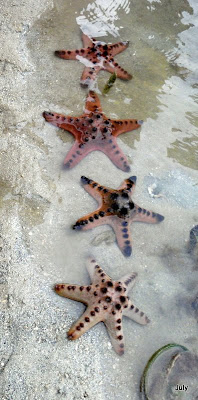103th Discovery Post:
As I left my house at about 4+am on Sunday morning, it was still drizzling and lighting flashed in the distance. The scene got me a little worried as we were heading out to Semakau yesterday morning (Sunday) and we would not be able to conduct an inter-tidal walk if a lighting alert has been given over the area.
Luckily for all of us, the clouds held on to its water droplets and this resulted with a cool and over-cast sky for a walk at the inter-tidal zone of Semakau.
Here's my group, puffer fish, standing on the trail which brings all visitors to the area through the sea grass meadows (picture below).
 After crossing the meadow, we came across this creature staring at us with its pair of eyes (picture below).
After crossing the meadow, we came across this creature staring at us with its pair of eyes (picture below). Our hunter seekers have managed to find us a spider conch, the first 'discovery' (picture below).
Our hunter seekers have managed to find us a spider conch, the first 'discovery' (picture below).  Discovery Note:
Discovery Note:1. As a result of their really nice shells, spider conches are not only collected for food, they are also collected for their shells.
2. Due to this collection, spider conches have been labelled as a 'vulnerable' on the Red list of threaten animals of Singapore.
3. That aside, the movement of spider conches is quite interesting. They make use of a curved, knifed shaped operculum or in short, a 'leg' or 'pole' to pole vault around.
4. The spikes that are found on the shell helps to prevent the spider conch are rolling around after making a 'hop'.
5. Read more about the spider conch @ http://www.wildsingapore.com/wildfacts/mollusca/gastropoda/strombidae/lambis.htm.
The following 'discoveries' of this posting will be star-filled. What do I mean?
First off, our second 'discovery', a juvenile cushion star (picture below) which we have been spotting for the last 2 to 3 months. Hopefully, we will continue to see it in our future visits. =D
 Discovery Note:
Discovery Note:1. They are more often seen during diving, so it is always a treat to spot them in the inter-tidal areas.
2. They have been found to feed on some species of hard corals. Their diet could also consist of immobile animals, organic particles found on sediments and sea weeds.
3. Read more about them @ http://www.wildsingapore.com/wildfacts/echinodermata/asteroidea/culcita.htm.
Despite being assigned to guide the last minute, I managed to spot several things on my own. Here's one of them, the six armed knobbly sea star which is slowly becoming the new star of our walks (picture below). Third 'discovery'.
 Here are all the knobbly sea stars which we have seen for this trip (picture below).
Here are all the knobbly sea stars which we have seen for this trip (picture below). Discovery Note:
Discovery Note:1. They can only be found on certain islands on the Northern and Southern side of Singapore, therefore, they can be considered as uncommon.
2. Interestingly, their knob patterns can be used to tell one knobbly sea star from another.
3. Like all sea stars, they require sea water for survival, so do not remove them from sea water if possible.
4. Read more about them @ http://www.wildsingapore.com/wildfacts/echinodermata/asteroidea/protoreaster.htm.
Another interesting find would be this yet-to-be identified sea star on Semakau (picture below). As I turned this sea star to view its bottom side, another surprise sprung on me. A tidy brittle star was on the under side of this sea star. It was a pity that I totally forgot to take a photo in the mist of my excitement. By the way, this is the fourth 'discovery'.
 It was one of the coolest morning walk compared to many other morning walks. What a great way to end the last morning walk @ Semakau. Next month, the tides will change and our trips out to the shores will start in the evenings...
It was one of the coolest morning walk compared to many other morning walks. What a great way to end the last morning walk @ Semakau. Next month, the tides will change and our trips out to the shores will start in the evenings...  Finally, it's thanks to all puffer fishes for being such an attentive group. =D Here's a group photo of everyone (picture above) with the knobbly sea stars.
Finally, it's thanks to all puffer fishes for being such an attentive group. =D Here's a group photo of everyone (picture above) with the knobbly sea stars.Extra:
a) Read Tidechaser's entry on this trip: http://tidechaser.blogspot.com/2009/08/semakau-walk-on-23-aug-2009.html
b) Read Manta's entry on this trip: http://mantamola.blogspot.com/2009/08/semakau-walk-on-23-august-09.html




